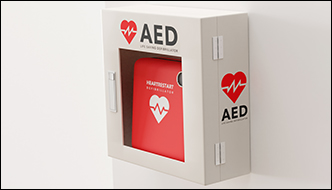
Automated External Defibrillators (AEDs) are life-saving devices used to treat sudden cardiac arrest (SCA) victims, not heart attack victims. It’s important to understand the distinction between a heart attack and sudden cardiac arrest:
- Heart Attack: A heart attack occurs when there is a blockage in one or more of the coronary arteries, which supply blood to the heart muscle. This blockage can lead to damage to the heart muscle. While a heart attack is a serious medical emergency, the heart continues to beat during a heart attack.
- Sudden Cardiac Arrest: Sudden cardiac arrest is a life-threatening condition that occurs when the heart’s electrical system malfunctions, causing the heart to stop beating effectively. The person will lose consciousness, have no pulse, and stop breathing. Sudden cardiac arrest requires immediate intervention to restore the heart’s normal rhythm.
Here’s how AEDs are used for sudden cardiac arrest victims:
- Recognize the Emergency: If you witness someone suddenly collapse and become unresponsive, check for responsiveness and breathing. It is likely sudden cardiac arrest.
- Call for Help: Immediately call for emergency medical assistance (911 or your local emergency number) to get professional help on the way.
- Retrieve the AED: If an AED is available nearby, send someone to fetch it while you continue to perform CPR on the victim.
- Apply the AED: Once the AED arrives, turn it on and follow the voice or visual prompts. Most AEDs have simple instructions, making them easy to use even for individuals without medical training.
- Attach the AED Pads: Expose the person’s chest and apply the AED pads as instructed. The pads should be placed on specific chest locations as indicated on the AED device.
- Stand Clear and Analyze: Ensure that no one touches the person and press the “analyze” button on the AED. The device will assess the person’s heart rhythm to determine if a shock is needed.
- Deliver a Shock (If Advised): If the AED advises a shock is necessary, make sure no one touches the person, and press the “shock” button as directed. The AED will deliver a controlled electric shock to the heart to attempt to restore a normal rhythm.
- Resume CPR: After the shock, or if no shock is advised, immediately resume CPR, starting with chest compressions.
- Continue Until Help Arrives: Follow the AED prompts, perform CPR until emergency medical personnel arrive and take over the treatment.
AEDs are designed to be user-friendly, and many public places, such as airports, schools, and shopping malls, are equipped with these life-saving devices. Quickly applying CPR and early use of an AED can significantly increase the chances of survival for a sudden cardiac arrest victim. If you witness someone collapse and suspects sudden cardiac arrest, remember to call for help, start CPR, and use an AED as soon as possible.
